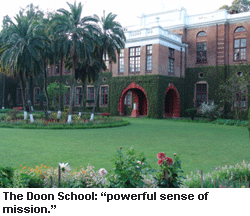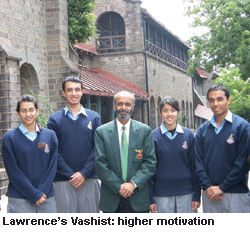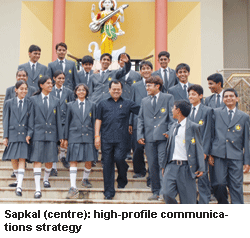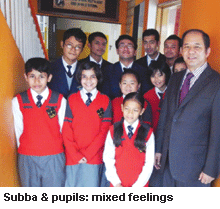 To avoid the pitfall of comparing oranges with apples, since last year the EW-C fore survey of India’s most respected schools has been demarcated into three clear categories — day, boarding and international. Self- evidently, public expectations of day and boarding schools tend to differ. In residential schools factors such as pastoral care (described in the survey as ‘individual attention to students’), infrastructure, sports and games education and leadership/ management quality, assume greater importance than in day schools where the prime focus tends to be on academic learning outcomes.
To avoid the pitfall of comparing oranges with apples, since last year the EW-C fore survey of India’s most respected schools has been demarcated into three clear categories — day, boarding and international. Self- evidently, public expectations of day and boarding schools tend to differ. In residential schools factors such as pastoral care (described in the survey as ‘individual attention to students’), infrastructure, sports and games education and leadership/ management quality, assume greater importance than in day schools where the prime focus tends to be on academic learning outcomes.
Moreover in India’s traditional boarding schools modeled on British public schools, there’s an inherited tradition of according sports and co-curricular education as much — if not more — importance as academics. As the Duke of Wellington famously remarked after a British-Prussian expeditionary force defeated le grande armee of French Emperor Napoleon in the Battle of Waterloo (1815) in Belgium, this battle was actually won on the playing fields of Eton College, the famous English public school (estb.1441). Hence boarding/ residential schools need to be assessed and evaluated with altogether different yardsticks.
Against this backdrop, the only constant of the past three Education-World annual surveys of India’s most respected boarding schools has been the recurrence of The Doon School, Dehradun in the No.1 position in the all-India and northern region league tables. Despite being ranked third in academic reputation, on the strength of its top rating under the parameters of leadership/ management quality, quality of alumni and infrastructure, Doon has topped the national and regional league tables again with an aggregate score of 1,100 out of a maximum possible 1,300.
 Comments Peter Mclaughlin, a history alumnus of the London School of Economics and former headmaster of The British International School, Cairo and St. George’s and Casterton schools, UK, who took charge as headmaster of Doon in July this year: “The Doon School has always had a powerful sense of mission and a very distinctive ethos. It was established to produce young men who lead free India to nationhood, and our genuine focus on the development of character and leadership qualities gives the school its enormous strength and reputation. Of course, our boys gain excellent grades and go on to top universities and colleges here and abroad. But the school has never compromised on its commitment to all-round education that offers almost unlimited opportunities and challenges to boys to discover who they are and develop intellect, character, a spirit of enquiry, self-discipline, moral and physical courage, strength and creativity.”
Comments Peter Mclaughlin, a history alumnus of the London School of Economics and former headmaster of The British International School, Cairo and St. George’s and Casterton schools, UK, who took charge as headmaster of Doon in July this year: “The Doon School has always had a powerful sense of mission and a very distinctive ethos. It was established to produce young men who lead free India to nationhood, and our genuine focus on the development of character and leadership qualities gives the school its enormous strength and reputation. Of course, our boys gain excellent grades and go on to top universities and colleges here and abroad. But the school has never compromised on its commitment to all-round education that offers almost unlimited opportunities and challenges to boys to discover who they are and develop intellect, character, a spirit of enquiry, self-discipline, moral and physical courage, strength and creativity.”
The next six ranks in the 2009 boarding schools league table have been awarded by sample respondents to the usual suspects — Rishi Valley, Chitoor; Mayo College, Ajmer; Lawrence, Sanawar; Welham Girls, Dehradun; Scindia School, Gwalior and St. Paul’s, Darjeeling. But a surprise entry into the Top 10 table 2009 is the newly-promoted Sarala Birla Academy, Bangalore (estb. 2004) which has moved up nine places to be ranked No. 8 this year. Lawrence, Lovedale (9); Mayo Girls, Ajmer (9 — ranked 14 last year) and Bishop Cotton, Shimla complete the Top 10 table.
Especially notable is the improved ranking of the Lawrence School, Sanawar which took prompt and firm action in expelling some senior students for ragging and indiscipline earlier this year — an incident that made media headlines in the north — and has risen in public esteem as a consequence. In the 2009 national league table it has moved up two places to be ranked No. 4 this year, and second in the northern region table on the strength of excellent ratings on the parameters of academic reputation, faculty competence and parental involvement.
 “I am delighted that Lawrence Sanawar has moved up into the Top 5 of the national and regional league tables of India’s most admired boarding schools. I attribute this to greater emphasis on academics aided by our substantial investment in new, smart classroom technologies and better discipline in the school. I believe team work, higher motivation levels and adherence to our motto ‘Never Give In’ are the other factors behind our improved ranking this year,” says Pravin Vashist, headmaster of this vintage classV-XII boarding school (estb.1847).
“I am delighted that Lawrence Sanawar has moved up into the Top 5 of the national and regional league tables of India’s most admired boarding schools. I attribute this to greater emphasis on academics aided by our substantial investment in new, smart classroom technologies and better discipline in the school. I believe team work, higher motivation levels and adherence to our motto ‘Never Give In’ are the other factors behind our improved ranking this year,” says Pravin Vashist, headmaster of this vintage classV-XII boarding school (estb.1847).
Further down the league table of residential schools, there has been a considerable churn this year. Welham Boys, Dehradun (18 to 11) and Daly College, Indore (22 to 14) have moved up handsomely. Ditto two deftly steered Eastern Region boarding schools — Assam Valley (39 to 19) and Himali Boarding (43 to 20) — have entered the all-India Top 20 and are ranked second and third regionally (after St. Paul’s, Darjeeling), but ahead of the highly fancied St. Joseph’s, North Point.
Another new and fast rising boarding school gaining esteem among the informed public, is the Nashik-based Orchid Interna-tional (estb.2006), which has successfully adopted a high-profile communications strategy. Although its all-India ranking has improved modestly (19 to17), in the Western Region it is ranked fourth this year. However on the critical parameters of faculty competence and quality of leadership, Orchid International is ranked a commendable second and fourth nationally. Perhaps even more impressively, the New Era School, Panchgani (Maharashtra), which was unranked last year, is listed 12 this year and has been highly rated on the parameters of individual attention to students and infrastructure provision. Could the hit movie Taare Zameen Par starring Aamir Khan and shot on the school’s premises be a contributory factor?
 “The staff and students of Orchid International are delighted to learn that our school has improved its national and regional rankings in the latest EW schools survey. In particular, I am very pleased that on the parameters of faculty competence and leadership/management quality we have been ranked second and fourth all-India, because these have been focus development areas of the school for the past year. Moreover the fact that we are also ranked second nationally on the parameter of co-curricular education, is proof that we have been successful in delivering balanced, holistic education to our students,” says Ravindra G. Sapkal, chairman and managing director, Orchid International School, Nashik (Maharashtra).
“The staff and students of Orchid International are delighted to learn that our school has improved its national and regional rankings in the latest EW schools survey. In particular, I am very pleased that on the parameters of faculty competence and leadership/management quality we have been ranked second and fourth all-India, because these have been focus development areas of the school for the past year. Moreover the fact that we are also ranked second nationally on the parameter of co-curricular education, is proof that we have been successful in delivering balanced, holistic education to our students,” says Ravindra G. Sapkal, chairman and managing director, Orchid International School, Nashik (Maharashtra).
On the other hand among the boarding schools which have slid down the league tables are St. John’s International Residential, Chennai (10 to 23); Maharani Gayatri Devi Public School, Jaipur (9 to 24); St. Joseph’s, North Point, Darjeeling (10 to 21); G.D. Birla Public, Ranikhet (28 to 34); Wynberg Allen, Mussoorie (23 to 31) and the Sainik Schools, Jamnagar and Satara (20 to 36) and (25 to 38) respectively.
Northern Region
Quite obviously India’s most admired boarding schools are concentrated in the north because institutions which dominate the Northern Region league table also dominate the all-India table. Moreover given that sample respondents were quizzed by C fore field researchers on the relative merits of schools in their own regions on the premise that they are likely to be more familiar with proximate institutions, regional rankings are arguably a more accurate assessment of their relative merits.
Therefore the rise of Lawrence, Sanawar in the regional league table (4 to 2), and of Welham Boys, Dehradun (9 to 6) is impressive. Disappointingly, among the schools which were ranked last year, but which have slipped below the radar and couldn’t get even 20 of the 703 northern region respondents to speak up for them included Vidya Devi Jindal, Hissar (regional rank 17 in 2008); DPS, Pinjore (17); Yadavindra Public, Patiala (18); Dalhousie Public (20); Brightland (21) and Manav Bharati International (22) schools, both in Dehradun.
Southern Region
Unsurprisingly, the Rishi Valley School, Chitoor, promoted by the venerated educationist-seer J. Krishnamurti (1895-1986) in 1926 which is ranked second in the boarding schools national league table this year, tops the southern region table.
Yet the school which has risen high in public esteem in peninsular India is the Sarala Birla Academy, Bangalore which has vaulted into the Top 10 nationally (17 to 8), and to second position regionally. This newly promoted (2004) CBSE-affiliated K-12 school has confounded sceptics by being rated highest countrywide for co-curricular education and among the Top 5 for competence of faculty, academic reputation and infrastructure facilities. Other Bangalore-based boarding schools which have risen high in the regional table this year are BGS International (8 to 4) and the Bangalore Military School (unranked to 7).
Among the institutions which have yielded rank in the league tables are St. John’s International Residential, Chennai (3 to 5); Jain International (4 to 6) and Chinmaya International, Coimbatore (6 to 8). But they have fared better than Amber Valley, Chikmaglur; Kotagiri Public, Kodaikanal and Peevees Public, Nilambur (Kerala) which couldn’t find more than 20 of the 563 southern respondents ready to rate them. Quite obviously they need to raise their public profiles.
Western Region
Expectedly, the vintage Mayo College, Ajmer (estb. 1875) ranked third all-India, topped the Western Region league table followed by its sister institution Mayo College Girls which has moved up one slot this year to make it a clean sweep for these Ajmer-based boarding schools. A surprise entrant into the top three is New Era School, Panchgani (Maharashtra) which was unranked last year.
Moreover Orchid International which within three years since it was promoted in 2006 has acquired a national reputation, has replaced Riverdale Interna-tional, Pune in the No. 4 slot with the latter positioned No. 6 after Maharani Gayatri Devi, Jaipur which has slipped sharply in the 2009 national (9 to 24) and regional (2 to 5) league tables.
Eastern Region
.gif) The nationally respected St. Paul’s School, Darjeeling (estb.1823) ranked No. 7 all-India, has effortlessly topped the Eastern Region league table. But this politically troubled region which doesn’t seem to have a strong boarding school tradition, has witnessed the spectacular rise of the painstakingly constructed Assam Valley School, Balipara which has vaulted into the national Top 20 (39 to 19) and the Himali Boarding School, Kurseong (43 to 20). Consequently they have also risen to the No. 2 and No.3 positions in the eastern league table, surprisingly besting the hitherto highly-fancied St. Joseph’s College, North Point, Darjeeling which has slipped nationally (10 to 21) and regionally (2 to 4).
The nationally respected St. Paul’s School, Darjeeling (estb.1823) ranked No. 7 all-India, has effortlessly topped the Eastern Region league table. But this politically troubled region which doesn’t seem to have a strong boarding school tradition, has witnessed the spectacular rise of the painstakingly constructed Assam Valley School, Balipara which has vaulted into the national Top 20 (39 to 19) and the Himali Boarding School, Kurseong (43 to 20). Consequently they have also risen to the No. 2 and No.3 positions in the eastern league table, surprisingly besting the hitherto highly-fancied St. Joseph’s College, North Point, Darjeeling which has slipped nationally (10 to 21) and regionally (2 to 4).
Comments D.N.A. Mountford, an alumnus of St. Stephen’s College, Delhi and London University who began his teaching career in Doon School prior to being appointed headmaster of the state-of-the-art Assam Valley School, promoted by tea tycoon B.M. Khaitan, in 1995: “I am pleased to learn that despite it being only 14 years old and sited in an obscure corner of the country, AVS has entered the ranks of the Top 20 residential schools in India and is ranked second in the eastern region. A favourable combination of factors — a progressive and supportive board of governors, excellent teachers attracted from across the country, constant upgradation of the school’s infrastructure and our talented students, the majority of them from the Seven Sister states of north-east India — is responsible for our rise in public esteem.”
 Robbie Subba, promoter-director of Himali Boarding School, Kurseong which has also made a spectacular leap forward in the esteem of the parent-educationist fraternity in eastern India, has mixed feelings about the EW Survey of Schools 2009. “As an alumnus and educator, I am of the opinion that St. Joseph’s, North Point, Darjeeling is the No.1 boarding school in eastern India. I attribute its fourth ranking to the modesty of its Jesuit management and its low profile. As to the spurt in our ranking, I ascribe it to the substantial investment HBS has made in modern ICT (information communication technologies) in our classrooms, in teacher recruitment and training and plain, old-fashioned hard work,” says Subba.
Robbie Subba, promoter-director of Himali Boarding School, Kurseong which has also made a spectacular leap forward in the esteem of the parent-educationist fraternity in eastern India, has mixed feelings about the EW Survey of Schools 2009. “As an alumnus and educator, I am of the opinion that St. Joseph’s, North Point, Darjeeling is the No.1 boarding school in eastern India. I attribute its fourth ranking to the modesty of its Jesuit management and its low profile. As to the spurt in our ranking, I ascribe it to the substantial investment HBS has made in modern ICT (information communication technologies) in our classrooms, in teacher recruitment and training and plain, old-fashioned hard work,” says Subba.
Regretably the Tashi Namgyal Academy, Gangtok and Dr. Graham’s Homes, Kalimpong which ranked fifth and sixth in the eastern region last year, didn’t have the minimum number (20) of the sample respondents willing to speak up for them in 2009.
Download Boarding Schools Zonal League Tables userfiles/Boarding Schools Zonal Tables.pdf
Download Parameters of Excellence: India's Top 10 Boarding Schools userfiles/Parameters of Excellence Boarding Schools.pdf
Download India's Best Boarding Schools League Table userfiles/Boarding Schools League Table.pdf